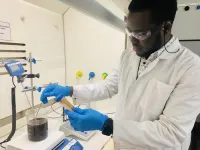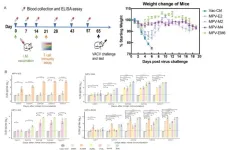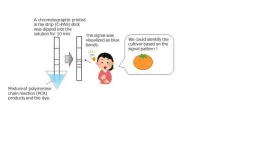(Press-News.org) “This technology is not alive,” says Laia Mogas-Soldevila. “It is living-like.”
The distinction is an important one for the assistant professor at the Stuart Weitzman School of Design, for reasons both scientific and artistic. With a doctorate in biomedical engineering, several degrees in architecture, and a devotion to sustainable design, Mogas-Soldevila brings biology to everyday life, creating materials for a future built halfway between nature and artifice.
The architectural technology she describes is unassuming at first look: A freeze-dried pellet, small enough to get lost in your pocket. But this tiny lump of matter, the result of more than a year’s collaboration between designers, engineers and biologists, is a biomaterial that contains a “living-like” system.
When touched by water, the pellet activates and expresses a glowing protein, its fluorescence demonstrating that life and art can harmonize into a third and very different thing, as ready to please as to protect. Woven into lattices made of flexible natural materials promoting air and moisture flow, the pellets form striking interior design elements that could one day keep us healthy.
“We envision them as sensors,” explains Mogas-Soldevila. “They may detect pathogens, such as bacteria or viruses, or alert people to toxins inside their home. The pellets are designed to interact with air. With development, they could monitor or even clean it.”
For now, they glow, a triumphant first stop on the team’s roadmap to the future. The fluorescence establishes that the lab’s biomaterial manufacturing process is compatible with the leading-edge cell-free engineering that gives the pellets their life-like properties.
A rapidly expanding technology, cell-free protein expression systems allow researchers to manufacture proteins without the use of living cells.
Gabrielle Ho, Ph.D. candidate in the Department of Bioengineering and co-leader of the project, explains how the team’s design work came to be cell-free, a technique rarely explored outside of lab study or medical applications.
“Typically, we’d use living E. coli cells to make a protein,” says Ho. “E. coli is a biological workhorse, accessible and very productive. We’d introduce DNA to the cell to encourage expression of specific proteins. But this traditional method was not an option for this project. You can’t have engineered E. coli hanging on your walls.”
Cell-free systems contain all the components a living cell requires to manufacture protein —energy, enzymes and amino acids — and not much else. These systems are therefore not alive. They do not replicate, and neither can they cause infection. They are “living-like,” designed to take in DNA and push out protein in ways that previously were only possible using living cells.
“One of the nicest things about these materials not being alive,” says Mogas-Soldevila, “is that we don’t need to worry about keeping them that way.”
Unlike living cells, cell-free materials don’t need a wet environment or constant monitoring in a lab. The team’s research has established a process for making these dry pellets that preserves bioactivity throughout manufacturing, storage and use.
Bioactive, expressive and programmable, this technology is designed to capitalize on the unique properties of organic materials.
Mogas-Soldevila, whose lab focuses exclusively on biodegradable architecture, understands the value of biomaterials as both environmentally responsible and aesthetically rich.
“Architects are coming to the realization that conventional materials — concrete, steel, glass, ceramic, etc. — are environmentally damaging and they are becoming more and more interested in alternatives to replace at least some of them. Because we use so much, even being able to replace a small percentage would result in a significant reduction in waste and pollution.”
Her lab’s signature materials — biopolymers made from shrimp shells, wood pulp, sand and soil, silk cocoons, and algae gums — lend qualities over and above their sustainable advantages.
“My obsession is diagnostic, but my passion is playfulness,” says Mogas-Soldevila. “Biomaterials are the only materials that can encapsulate this double function observed in nature.”
This multivalent approach benefited from the help of Penn Engineering’s George H. Stephenson Foundation Educational Laboratory & Bio-MakerSpace, and the support of its director, Sevile Mannickarottu. In addition to contributing essential equipment and research infrastructure to the team, Mannickarottu was instrumental in enabling the interdisciplinary relationships that led the team to success, introducing Ho to the DumoLab Research team collaborators. These include Mogas-Soldevila, Camila Irabien, a Penn Biology major who provided crucial contributions to experimental work, and Fulbright design fellow Vlasta Kubušová, who co-led the project during her time at Penn and who will continue fueling the project’s next steps.
The cell-free manufacturing and design research required unique dialogues between science and art, categories that Ho believed to be entirely separate before embarking on this project.
“I learned so much from the approach the designers brought to the lab,” says Ho. “Usually, in science, we have a specific problem or hypothesis that we systematically work towards.”
But in this collaboration, things were different. Open-ended. The team sought a living-like platform that does sensing and tells people about interactive matter. They needed to explore, step by step, how to get there.
“Design is only limited by imagination. We sought a technology that could help build towards a vision, and that turned out to be cell-free” says Ho.
“For my part,” says Mogas-Soldevila, “it was inspiring to witness the rigor and attention to constraints that bioengineering brings.”
The constraints were many — machine constraints, biological constraints, financial constraints and space constraints.
“But as we kept these restrictions in play,” she continues, “we asked our most pressing creative questions. Can materials warn us of invisible threats? How will humans react to these bioactive sites? Will they be beautiful? Will they be weird? Most importantly, will they enable a new aesthetic relationship with the potential of bio-based and bioactive matter?”
Down the line, the cell-free pellets and biopolymer lattices could drape protectively over our interior lives, caring for our mental and physical health. For now, research is ongoing, the poetry of design energized by constraint, the constraint of engineering energized by poetry
END
The art and science of living-like architecture
2023-06-21
ELSE PRESS RELEASES FROM THIS DATE:
Phone communication spurs a cascading effect on social influence
2023-06-21
AUSTIN, Texas – Social influence from phone communications is significant, reaching as far as four degrees of separation from the original caller, according to a new study from researchers at The University of Texas at Austin, who developed a new framework to more precisely study the phenomenon.
The researchers created a framework that distinguishes between people behaving in similar ways because of peer influence or because they’ve sought out friends with similar behaviors and beliefs. It’s an important distinction to make for marketing and public health agencies looking to effectively ...
New findings show mitochondrial DNA fragments in blood as important biomarkers for aging and inflammation
2023-06-21
In an eight-year study of more than 600 community-dwelling older adults, Johns Hopkins Medicine researchers say they have further linked levels of cell-free DNA (DNA fragments resulting from cell death) circulating in the blood to chronic inflammation and frailty. The study is novel and expands on previous work, the investigators say, because it focused on mitochondrial DNA rather than solely genomic DNA, as previously reported in October 2022.
The new findings, published May 23 in Immunity ...
Engineers “strike gold” with innovation that recovers heavy metals from biosolids
2023-06-21
Engineers in Melbourne have developed a cost-effective and environmentally friendly way to remove heavy metals, including copper and zinc, from biosolids.
The team’s work, led by RMIT University in collaboration with South East Water and Manipal University in India, advances other methods for heavy-metal removal by recycling the acidic liquid waste that is produced during the recovery phase, instead of throwing it away.
Lead senior researcher Professor Kalpit Shah from RMIT said the heavy metals found in biosolids ...
Multi-valent mRNA vaccines against monkeypox enveloped or mature viron surface antigens for enhanced protection
2023-06-21
A team of researchers from the Chinese Academy of Sciences, the Chinese Academy of Agricultural Sciences, and Beijing Institute of Pharmacology and Toxicology have made significant progress in developing multi-valent mRNA vaccines against monkeypox virus (MPV), the agent that can cause smallpox-like disease in humans. Their study showed the multi-valent mRNA vaccines with different combinations of monkeypox enveloped viron (EV) or mature viron (MV) surface antigens induced dynamic immune responses with a robust IgG response and correlating neutralizing activities. The ...
People who develop diabetes after pregnancy are less likely to regain control of blood sugar if they had gestational diabetes
2023-06-21
People who develop diabetes following pregnancy were significantly less likely to be able to bring it under control if they had experienced gestational diabetes during their pregnancy, especially if they were Black or Hispanic, according to a Mount Sinai study published on June 21 in the journal Diabetes Care.
The study also found that people who experienced gestational diabetes were more than 11 times as likely as those whose pregnancies did not involve gestational diabetes to develop diabetes within nine years after delivery.
The researchers, from the Icahn School of Medicine at Mount Sinai, found that the ...
Helping ‘good’ gut bacteria and clearing out the ‘bad’ — all in one treatment
2023-06-21
Probiotics can help maintain a healthy gut microbiome or restore populations of “good bacteria” after a heavy course of antibiotics. But now, they could also be used as an effective treatment strategy for certain intestinal diseases, such as Crohn’s disease. Researchers reporting in ACS Central Science have developed a microgel delivery system for probiotics that keeps “good” bacteria safe while actively clearing out “bad” ones. In mice, the system treated intestinal inflammation without side effects.
In the digestive system, there’s a delicate balance of bacterial populations. ...
FDA grants de novo clearance to Tristel ULT™ as a high-level disinfectant for ultrasound applications
2023-06-21
FAIRFIELD, NJ—Parker Laboratories Inc., a worldwide leader in ultrasound supplies and accessories, has announced the US Food and Drug Administration (FDA) has granted clearance for a unique disinfecting foam, called Tristel ULT, as a high-level disinfectant for ultrasound probes used within body cavities and for skin-surface transducers.
Tristel ULT is manufactured and distributed for US markets by Parker Laboratories under an exclusive commercial partnership with UK-based Tristel plc (AIM: TSTL). Tristel ULT is a high-level disinfectant using a proprietary ...
Banks still offer Black entrepreneurs inferior loans, service even when they are better qualified than peers
2023-06-21
Nearly a decade ago, researchers from Brigham Young University, Utah State University and Rutgers published a disheartening study revealing how discrimination in bank loan services was tainting the American Dream for minority entrepreneurs.
Unfortunately, even in 2023, not much has changed. A newly published paper from this core group of authors finds banks still offer Black customers inferior loan products and service, even when those Black customers have objectively stronger financial profiles and FICO ...
Researchers to train farmers on how to reduce greenhouse gas emissions, improve soil health
2023-06-21
EL PASO, Texas (June 21, 2023) — In 2021, agricultural activities contributed to 10 percent of greenhouse gas emissions in the U.S. Now, researchers at The University of Texas at El Paso will help reduce these emissions by training farmers across the nation on climate-friendly agricultural practices.
The project is supported by a new $2 million, four-year grant from the U.S. Department of Agriculture (USDA).
The team behind the Carbon SMART (Soil Monitoring, Assessment, Research and Training) project includes soil scientists and geochemists from UTEP as well as geomorphologists, landscape ecologists, sociologists, and environmental anthropologists from ...
A novel solution to safeguard Japan's unique citrus cultivars and their breeders’ rights
2023-06-21
Citrus cultivation holds significant importance in Japan and has recently attracted both domestic and global attention. With an agricultural production value of approximately 201 billion yen, citrus is the third most important agricultural product in Japan. The success of the Japanese citrus industry is attributed to the development of new cultivars that are free of pests and diseases, climate-resilient, and exhibit superior fruit quality. Notable examples include 'Asumi', 'Asuki', 'Ehimekashidai28go', 'Ehimekashidai48go', 'Himekoharu', 'Kanpei', 'Rinoka', and 'Mihaya', all of which display improved agricultural ...




